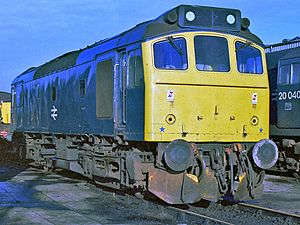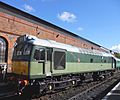British Rail Class 25 facts for kids
Quick facts for kids British Rail Class 25 |
|
 |
|
| Class 25 locomotive stands on Springs Branch Traction Maintenance Depot at Wigan | |
| Power type | Diesel-electric |
|---|---|
| Builder | British Railways’ Crewe Works, Darlington Works and Derby Works; Beyer, Peacock & Co. |
| Build date | 1961–1967 |
| Total production | 327 |
| Configuration | Bo-Bo |
| UIC classification | Bo'Bo' |
| Gauge | 4 ft 8 1⁄2 in (1,435 mm) |
| Wheel diameter | 3 ft 9 in (1.143 m) |
| Minimum curve | 4.5 chains (91 m) |
| Wheelbase | 36 ft 6 in (11.125 m) |
| Length | 50 ft 6 in (15.392 m) |
| Width | 9 ft 1 in (2.769 m) |
| Height | 12 ft 8 in (3.861 m) |
| Locomotive weight | 71 long tons (72.1 t) to 76 long tons (77.2 t) |
| Fuel capacity | 500 imp gal (2,300 L; 600 US gal) |
| Prime mover | Sulzer 6LDA28-B |
| Transmission | DC generator, DC traction motors |
| Multiple working | ★ Blue Star |
| Top speed | 90 mph (145 km/h) |
| Power output | Engine: 1,250 hp (932 kW) |
| Tractive effort | Maximum: 39,000 lbf (173,000 N) to 45,000 lbf (200,000 N) |
| Train heating | Steam generator |
| Locomotive brakeforce | 38 long tons-force (380 kN) |
| Train brakes | Vacuum |
| Career | British Railways |
| Number | D5151–D5299, D7500–D7677; later 25001–25327 |
| Nicknames | Rats |
| Axle load class | Route availability 4 |
The British Rail Class 25 was a type of diesel locomotive used in the United Kingdom. These powerful engines were originally called British Railways Type 2 locomotives. They were given the nickname Rats by railway workers.
A total of 327 of these locomotives were built. They were made between 1961 and 1967. The Class 25s became a common sight on railway lines across Britain.
Contents
British Rail Class 25 Locomotives
The British Rail Class 25 locomotives were a very important part of the railway system in the UK. They were designed to be strong and reliable. These trains helped move goods and people all over the country for many years.
What Were They?
The Class 25 was a diesel-electric locomotive. This means it used a diesel engine to power a generator. The generator then made electricity, which powered electric motors that turned the wheels. It was a common way to build powerful trains.
They were known for their simple but tough design. This made them good for many different jobs on the railway. They had a top speed of about 90 miles per hour (145 km/h).
Building the "Rats"
The 327 Class 25 locomotives were built by British Railways itself. They were made at several large railway workshops. These included Crewe Works, Darlington Works, and Derby Works. Another company, Beyer, Peacock & Co., also helped build some of them.
Building so many locomotives in a few years showed how much British Railways needed them. They were a key part of modernising the railway system.
What They Did
Class 25 locomotives were very versatile. This means they could do many different kinds of jobs. They were often used for:
- Freight trains: Carrying goods like coal, steel, and other materials across the country. This was one of their main roles.
- Passenger trains: Sometimes, they pulled passenger coaches, especially on local or secondary lines.
- Shunting: Moving wagons around in railway yards.
Their ability to handle both heavy freight and passenger duties made them very useful. They were a workhorse for British Railways for many years.
End of the Line
By the 1980s, newer and more powerful locomotives were being introduced. These new trains could do the same jobs more efficiently. Because of this, the Class 25s slowly started to be taken out of service.
The last Class 25 locomotives were officially retired from British Rail service in 1987. After many years of hard work, their time on the main railway lines came to an end.
Where Can You See Them Now?
Even though they are no longer used by British Rail, some Class 25 locomotives have been saved. These preserved trains can now be found on heritage railways across the UK. People can visit these railways to see the "Rats" in action. It's a great way to experience a piece of railway history.
Images for kids
-
D7585 working as Derby station pilot in May 1965. The livery is BR green with small yellow warning panels.






